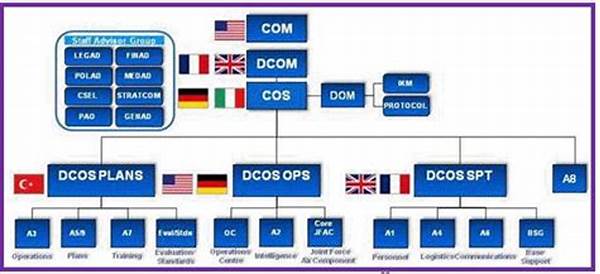Introduction to Allied Joint Command Structures
Allied joint command structures represent a pivotal component in the strategic military operations of multinational alliances, notably within organizations such as NATO. These structures play a crucial role in coordinating the military efforts of member nations, ensuring a unified and effective response to various security challenges. The framework is designed to manage and direct combined military forces towards achieving shared objectives, thus facilitating interoperability among diverse national militaries. Through the establishment of common doctrines and operational procedures, allied joint command structures enable coalition forces to operate cohesively.
In essence, allied joint command structures are tailored to address complex security needs in a multifaceted global environment. They provide the necessary command and control mechanisms that enable swift decision-making and operational flexibility. As geopolitical tensions ebb and flow, the ability of these structures to adapt and recalibrate strategic and tactical approaches remains paramount. Each component within the allied joint command structures is attuned to specific roles, from planning to execution, thereby ensuring that coalition forces are well-positioned to counter diverse threats with precision.
Moreover, allied joint command structures facilitate the sharing of intelligence, technological resources, and logistical support among member nations. This collaborative synergy not only strengthens the collective defense posture but also exemplifies the principles of partnership and mutual assistance. By enhancing communication and coordination capacities, these structures foster a comprehensive defense strategy, leveraging the strengths of each participating nation to achieve a harmonized military effort. The adept orchestration of allied joint command structures is instrumental in safeguarding international peace and stability.
The Role and Functionality of Allied Joint Command Structures
1. Allied joint command structures are integral to maintaining operational coherence among coalition forces, thereby enhancing their ability to respond to crisis situations swiftly and effectively. Their design ensures that all participating nations can contribute their military capabilities efficiently.
2. The integrated nature of allied joint command structures facilitates seamless communication and information-sharing channels. This is vital for the synchronization of military strategies and operations across various theaters of operations.
3. By employing standardized operational procedures, allied joint command structures ensure that participating forces can operate under a common strategic framework, thus minimizing the risks associated with cultural and procedural discrepancies.
4. The establishment of allied joint command structures underscores the commitment of member nations to collective security. Through these structures, allies demonstrate their resolve to protect mutual interests and uphold international security standards.
5. A fundamental aspect of allied joint command structures is their adaptability. These structures are continuously evolving to counter emerging threats, ensuring that multinational forces remain agile and prepared to address dynamic security challenges.
Strategic Importance of Allied Joint Command Structures
Allied joint command structures stand as pillars of international security collaboration, embodying the strategic imperatives of multilateral cooperation in addressing common threats. Their configuration enables the integration of diverse military capabilities, pooling resources from various nations to tackle shared challenges. This collaborative approach not only maximizes collective defense potential but also enhances the strategic reach and operational effectiveness of alliances. By fostering unity of effort and purpose, allied joint command structures significantly contribute to a robust and responsive defense posture.
At the heart of these structures lies a commitment to interoperability, which is instrumental in overcoming the complexities associated with multinational military operations. Allied joint command structures provide the framework within which forces from different nations can train, plan, and execute operations cohesively, ensuring that tactical and strategic objectives are met with precision. The ability of these structures to facilitate real-time coordination and decision-making is paramount in navigating the multifaceted security landscape. In essence, allied joint command structures represent a crucial enabler for the sustained success of multinational defense initiatives.
Evolution and Challenges Facing Allied Joint Command Structures
The development of allied joint command structures has seen significant transformation over the decades, adapting to the changing contours of global security threats. These structures must evolve continuously to counter new and sophisticated threats in the cybersecurity, hybrid warfare, and asymmetric conflict realms. The dynamic nature of these challenges necessitates a flexible and forward-thinking approach to command and control, which allied joint command structures adeptly provide.
Nonetheless, the intricacies involved in aligning multinational military doctrines and capabilities pose inherent challenges to the effectiveness of allied joint command structures. The differing strategic priorities and political dynamics of member nations can create friction points, necessitating diplomatic and operational finesse to maintain cohesion. Despite these challenges, the resilience and adaptability of allied joint command structures ensure they remain pivotal to global security frameworks, continually adjusting and refining their operations to preempt and neutralize potential threats.
Enhancing Capacity and Capability of Allied Joint Command Structures
Efforts to bolster the capacity and capability of allied joint command structures focus on promoting technological integration, resource optimization, and human capital development. By investing in cutting-edge technologies and training, these structures can enhance their operational readiness and resilience against evolving threats. Technology serves as a crucial force multiplier, enabling allied joint command structures to extend their strategic reach and operational impact.
Additionally, fostering a culture of innovation and learning within these structures is vital for maintaining competitive advantage. Continuous professional development and intercultural exchange programs for personnel within allied joint command structures facilitate the cultivation of a highly skilled and adaptable workforce. As these structures predicate their success on the adaptability and proficiency of their human resources, prioritizing these aspects ensures that they remain at the forefront of global defense strategies.
The Future of Allied Joint Command Structures
The prospective trajectory of allied joint command structures is marked by both opportunity and complexity. As international alliances increasingly turn to collaborative defense initiatives to address multifaceted threats, the significance of these structures continues to grow. Future-oriented strategies must encapsulate adaptability, innovation, and sustained engagement with emerging technological domains to ensure allied joint command structures can anticipate and act upon evolving security challenges effectively.
Respective to global geopolitical shifts, allied joint command structures must practice acumen in managing divergent national interests while fostering united strategic objectives. The successful integration of emerging technologies such as artificial intelligence and cyber capabilities will be instrumental in modernizing these structures, enabling them to maintain strategic relevance. As allies persist in navigating the intricacies of modern warfare, the allied joint command structures will remain indispensable to cultivating a secure international order.
Summary and Conclusion
In summary, allied joint command structures represent essential elements in the orchestration of multinational military operations. These frameworks facilitate the alignment of strategic and tactical goals among participating nations, ensuring a coordinated military response to an array of security threats. Emphasizing interoperability and communication, allied joint command structures are indispensable to realizing efficient and effective defense strategies on a global scale.
Moreover, as security challenges continue to evolve, so too must these structures in order to remain effective. Adapting to changing global dynamics is crucial, demanding ongoing investments in technology, training, and cooperative engagement. Ultimately, the success of allied joint command structures lies in their ability to coalesce diverse military entities into a formidable and cohesive force, underscoring the critical importance of allied collaboration in preserving international peace and stability.





